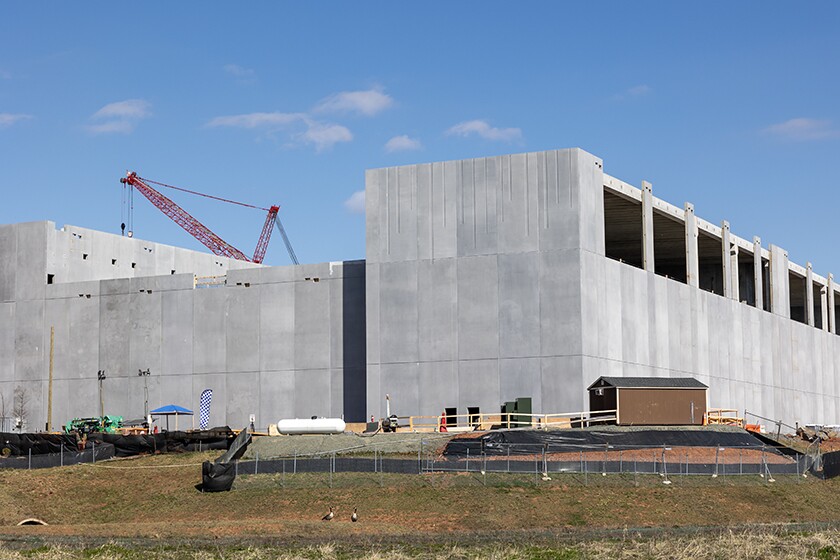
(Photographs by David Kidd)
In Brief:
As the exponential proliferation of smartphones, streaming services and doorbell cameras continues unabated, there is a corresponding need for data storage and dissemination. To meet the demand, more and more data centers are coming online in Dallas, Chicago, Northern California, New York and New Jersey.
By a wide margin, Northern Virginia is the No. 1 site for data centers in the country and the world. These highly specialized buildings house the computer servers and routers that make digital interconnectivity possible.
Just beyond the far-western suburbs of Washington, D.C., Ashburn, Va., is the epicenter of “Data Center Alley,” anchoring a collection of nearly 300 data centers, scattered across Loudoun, Fairfax and Prince William counties, handling more than a third of the world’s online traffic. Many more are in the planning stages or currently under construction.
Early data centers were built as massive featureless boxes, surrounded by spiked fences and nearly devoid of aesthetic appeal. More recently, attempts have been made to soften their appearance with the use of glass, color, architectural flourishes and landscaping. Many of the newer examples look more like oversized suburban office parks than warehouse distribution centers. But unlike offices and warehouses, data centers pay taxes but require little in the way of government services in return.
Loudoun County alone takes in close to $600 million annually in tax revenue from data centers, enough to cover all the county’s operating expenditures. A report by the Northern Virginia Technology Council estimates that the area’s data centers were responsible for nearly $174 million in state revenue and $1 billion in local tax revenue in 2021.

Location, Location, Location
Northern Virginia didn’t become the data center capital of the world by accident. Proximity to the nation's capital had a lot to do with it, at least initially. In the 1960s, a federally funded precursor to the Internet was created to link the Department of Defense with research institutions and universities, creating a need for data storage. These early achievements in network connectivity laid the groundwork for what would become the Internet.
In 1992 a group of network providers in Virginia joined forces to create one of the first network access points, providing an “Internet on-ramp.” America Online, later known as AOL, soon moved its corporate headquarters to Loudoun, bringing investments in fiber-optic cable and energy infrastructure with it. Established companies and tech entrepreneurs followed, installing fiber, spinning off new companies and building momentum for what would follow.
With plenty of affordable land, low-cost energy, little threat of natural disasters and a robust fiber network, Northern Virginia was soon recognized as the perfect place to expand the Internet. Virginia was one of only a handful of states that offered incentives to the nascent industry when it enacted its first data center tax exemption in 2009. Today more than 30 states offer similar exemptions.

An Appetite for Energy
As the proliferation of data centers in Northern Virginia continues, Data Center Alley may soon be a victim of its own success. The industry’s seemingly insatiable appetite for electricity is running up against a finite supply. Dominion Energy supplies electricity to much of Virginia, 20 percent of which is consumed by data centers. In just the last few years, the utility has connected 70 new centers, equivalent to powering 650,000 homes.
A year ago, Dominion admitted that its transmission infrastructure had not kept pace with the proliferation of data centers, warning that it might not be able to meet their power needs going forward. Substation expansions and new transmission lines are among a host of improvements underway following a temporary pause in new data center connections.

Amazon, Apple, Meta and Microsoft are among the many companies that have declared their intention to eventually be powered 100 percent by renewable energy. How and when that will happen remains unclear. Rooftop solar installations would only produce a small fraction of the energy a data center uses. Off-site solar will require vast amounts of land to be cleared, increasing the industries’ already large footprint and raising the ire of rural residents.

Still No. 1
Loudoun, Fairfax and Prince William counties continue to lure data centers to set up shop in Northern Virginia, enticing their owners with tax breaks and streamlined permitting. At one time the massive structures were largely out of sight. With their proliferation, they have become harder to ignore, igniting opposition to projects that encroach on residential neighborhoods and Civil War battlefields.
Many are beginning to weigh the economic benefits against quality-of-life and environmental costs. A controversial plan to site large data centers on 2,000 acres of rural farmland in Prince William County was passed last fall despite vocal opposition. In the political fallout, a prominent member of the board of supervisors and proponent of the plan was recently defeated in the Democratic primary. Even as some Northern Virginians are becoming increasingly resistant to new data centers, Gov. Glenn Youngkin envisions a future of statewide expansion, recently announcing a $35 billion deal with Amazon Web Services to establish several new campuses.
Wherever they are located, the need for data centers is only going to increase in the coming years, spearheaded by the use of AI which depends on massive amounts of data and computing power, and lots of electrical energy. Despite the recent setbacks, it’s unlikely that Northern Virginia will lose its position as the No. 1 data center location any time soon, even as other jurisdictions in Virginia and across the country vie for a piece of the action.











